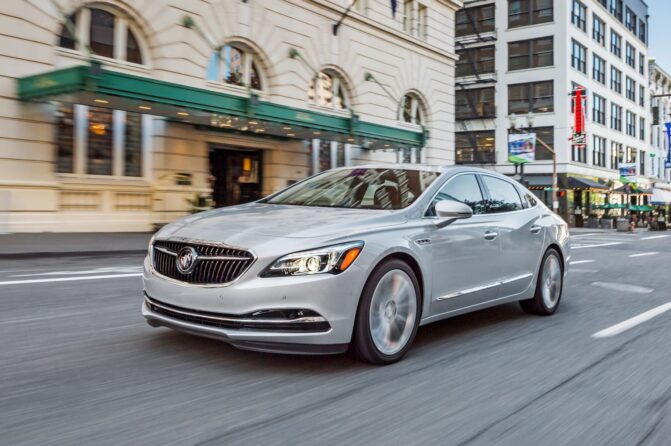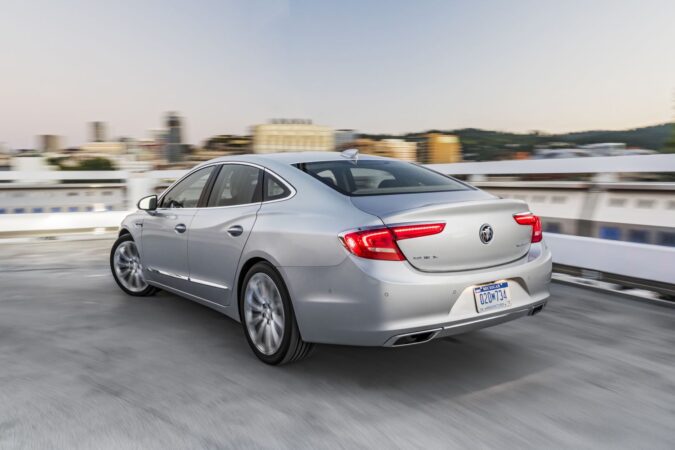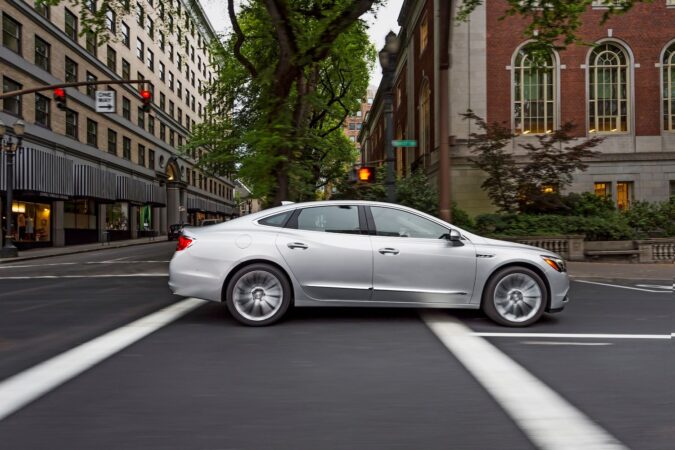The LaCrosse is a mid-size sedan that Buick’s been making since 2004. Now in its third generation, the Buick LaCrosse is selling well in international markets like China, but here in the US, production for the LaCrosse stopped in 2019. Over the past few years, Buick has garnered a pretty positive reputation for reliability but does the LaCrosse have serious problems?
Buick’s LaCrosse never really set the world alight, but it was generally a decent car. Reviews were mainly positive, particularly from the second generation onward. By then, it had better safety ratings, a focus on luxury, good performance, and they were really comfy. The third-generation LaCrosse was especially handsome, too. But, it wasn’t immune to issues.
Numerous recalls were issued by Buick over the years to settle sporadic issues with the LaCrosse. This included fixes for software issues with the powertrain, power seats, seat belts, suspension assembly, and airbags. But, aside from these recalls, not everything was solved by Buick. Here are some of the most common Buick LaCrosse problems…
1. Check Engine Light Constantly Turning On
This problem mostly plagues the second-generation LaCrosse. Owners with only around 25,000 miles on the clock report that their check engine light is constantly turning on. Some even report a burning smell coming from the car. The problem seems to stem from excessive carbon buildup. The latter is a persistent and systemic issue with this generation’s LaCrosse.
While carbon buildup is normal, especially in direct injection engines, the LaCrosse has excessive carbon buildup during cold starts. This causes the engine to misfire, which then triggers the check engine light. There seems to be no clear solution either. Owners report that GM dealers will try to replace a fuel module, which manages extracting fuel from the tank.
However, the check engine light quickly reappears after this solution. It’s not quite clear what the exact solution is. It seems replacing the spark plugs and fuel injectors will solve the issue, but it’ll appear again in about a year. This isn’t normal unless you’re doing over 50,000 miles in a year. The engines in this second-generation car were simply poorly designed.
2. Headlights Intermittently Turning Off On Their Own
The first-generation Buick LaCrosse had problems with their headlights intermittently going off on their own. Or sometimes, they just downright won’t turn on at all, specifically with their low-beam lights. The solution seems to be quite simple; an HDM (Headlight Driving Module) replacement for the Buick LaCrosse should do the trick.
Although GM acknowledges this problem, they haven’t made any recalls to fix this. Note, that the HDM is responsible for managing and ensuring the operation of the headlights. This means you’ll have to pay out of pocket. But don’t worry, owners report that it’s no more than $30 to replace. While the low beam is affected, the high beams should work just fine.
This isn’t exactly a serious issue, but driving with high beams constantly may earn you a ticket. You may get away with a “fix-it” ticket which costs less than $100 to pay. But a moving violation ticket will cost you $160 and more points on your license. As such, it’s best to address the issue and replace the HDM now that you’re aware of it to avoid tickets.
3. Door Lock Locking & Unlocking Problems
This is another problem that also plagues the first-generation Buick LaCrosse. Owners report intermittent problems locking and unlocking their doors. Their cars would sometimes just randomly lock or, more terrifyingly, won’t unlock when they’re inside. Some owners even have to lock each door individually every single time they want to leave their car.
The problem stems from faulty body control modules and door lock actuators. When these fail, the LaCrosse will have trouble operating the door locks. Owners report that this problem occurs when they reach the 70,000-mile mark and can cost up to $500 to fix. Thankfully, if you’re handy enough, you could replace the door lock actuators yourself for cheaper.
4. Cooling System Leaks
Some of the earlier model year Buick LaCrosse models had cooling system issues, where coolant would slowly leak from your car. This mostly impacted Buick LaCrosses that were fitted with the 3.8-liter V6 engine. Owners report that the coolant leak is very slow, and can take up to five months until the coolant level gets so low that the car overheats.
A slow leak of this kind can be very difficult to diagnose. The underlying fault of this problem likely stems from a worn-out intake manifold gasket. The intake manifold is a component that distributes airflow between the cylinders, and it has a gasket that connects it to the engine. When the gasket is worn, coolant can seep out, slowly reducing the coolant level over time.
And, this eventually causes your car to overheat. Owners of Buick LaCrosses report that this coolant problem went away after replacing the intake manifold gasket. This will cost somewhere between $250 – $350 to replace. Thankfully, this cooling system leakage issue was mostly solved by the time the second-generation Buick LaCrosse came out in 2010.
5. Faulty Ignition Module
Some owners of the first-generation LaCrosse reported that their cars would stall while they were driving. This is pretty scary, as it’s incredibly dangerous for a car to suddenly shut off and stall suddenly while you’re driving. The underlying cause of this random stalling issue seems to stem from faulty ignition modules and ignition wires that shorted.
When the ignition module and/or wires fail, the ignition coil won’t be able to send power to the spark plugs. And, when the spark plugs aren’t getting power, they won’t be able to create a solid spark that ignites the fuel and air mixture in the engine. When this happens, your Buick LaCrosse’s engine will cease to operate. This is what causes the random stalling.
A new, replacement ignition module is usually around $350 to replace, while a set of new ignition cables for the LaCrosse is somewhere around $60. However, an owner reported that they had the ignition module and wires replaced at a Buick dealer, and it cost them around $900 to get the job done. So, it’d be a good idea to call up your dealer beforehand.
6. “Reduced Engine Power” Warning Light
One of the more prevalent issues with the Buick LaCrosse is a common engine problem that owners have reported: “Reduced Engine Power”. Owners report that they see a ‘Reduced Engine Power’ warning light turning on, at around 60,000 miles on average. After a while, the check engine light turns on as well. Reduced Engine Power is similar to limp mode.
This is where your car’s ECU (Engine Control Unit) decreases the power output and limits performance on purpose. This usually indicates a serious problem with your car’s engine or transmission, and the ECU is preventing further damage by reducing the engine’s workload. It’s not clear what the cause of the problem is, as owners seem to be facing different issues.
Some owners cleaned the throttle body and the problem went away, while others had to replace their fuel pump and sensor, and some others had to replace their accelerator pedal. It’s one of those flaws where it’s not quite clear what the root cause is, and GM isn’t admitting the problem. This makes life pretty difficult for owners keen on finding a permanent fix.
7. Timing Chain Failure
When the second-generation Buick LaCrosse was introduced, two common problems that owners experienced were timing chain failure and faulty throttle bodies. A bad timing chain can produce a loud rattling noise from the engine and trigger the check engine light (CEL). These are some early signs of failure. The throttle body sensor is also known to fail in the LaCrosse.
The sensors inside them can misalign and when they’re not in sync, they can trigger the check engine light and also cause performance issues. Speaking of, some of the earlier second-gen Buick LacCrosses had engine stalling and sudden shutoff problems, which didn’t really have a definitive and permanent fix. In addition, excessive carbon buildup remained.
8. Air Conditioning Issues
Throughout several model years of the Buick LaCrosse, across the second and third generations, in particular, owners have also reported air-conditioning problems. Owners report that the air-conditioning system in their LaCrosse isn’t working properly and that the defroster isn’t wide enough. This would be a problem if you live either in hot or cold areas.
It’s not quite clear what the cause of the problem is, but it’s usually a clogged expansion valve, a faulty compressor clutch, a bad AC compressor, a blown fuse, or possibly a Freon leak. The LaCrosse is more prone to experiencing these problems than other cars. This usually occurs at around 30,000 miles. AC repairs should generally cost $150 – $200.



